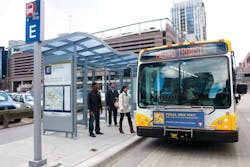In 2002, Richard Pace, president of Cumberland Development LLC., found a building in an old area of Cleveland near 71st Street and Euclid Avenue, which he saw potential to develop.
The building — known as the Baker Electric Building — had great architecture and a lot of potential, however, Pace looked at the surrounding neighborhood and knew the area wasn’t ready for investment yet, so he instead undertook a development in the suburbs.
In 2006, he went back to look at the old building again, but this time the city and the Greater Cleveland Regional Transit Authority were in the midst of building its new bus rapid transit line along the Euclid corridor.
“When I saw it under construction and that an investment was being made into the Euclid corridor, I decided it was time for me to make an investment,” he said. “Once I saw an investment was being made in the area I felt it was going to be a good investment for me.”
Pace was right. Within three years of his investment being made and the BRT line opening, he saw the 50,000 square feet of space within the Baker building leased out to biomedical startups and a competing investor was able to lease out 250,000 square feet of space nearby.
And Cleveland has since become a model to show other cities that BRT lines can start economic booms in old parts of town.
Bus Rapid Growth
Kenneth Sislak, associate vice president, senior project manager, transportation for AECOM, cites the Euclid Avenue project in Cleveland as the true measure of the impact BRT can have on development. The area had fallen on hard times in the past 30 years and the line was seen as a potential tool to not only lower travel times, but to be used as an economic tool.
More than $4.3 billion in development took place along the line since, including more than $80 million in renovations to Playhouse Square and another $50 million in renovations to the theater itself.
“I can’t say enough about the transformation of the Cleveland State Campus,” he said. “They’re building market rate apartment buildings along the corridor and old commercial buildings are being converted into high end residential lofts with great views of Lake Erie. It has been very transformational and it spills off all the way down the corridor.”
Sislak said part of the line goes into East Cleveland, which has been a highly economically depressed area for years. However, the BRT line has even spurred development there.
A recent study performed by the American Public Transportation Association and the National Realtors Association also showed BRT lines also were beneficial in stabilizing home prices during the most recent recession. According to the study, along BRT transit zones in Boston there was a 317 percent change in average residential sale prices at just one station area and along the corridor. Condos saw an average price increase within the transit shed with single family homes and townhouses held their value better than areas not along transit sheds. The entire rapid transit shed did 227 percent better in retaining value than the region as a whole between 2006 and 2011, with homes along the BRT shed having the best access to transit and jobs, and having the most walkable neighborhoods.
David Sampson, national practice leader, bus operations and strategic planning for AECOM, said the silver line in Boston has seen $571 million in investment along its corridor since 2008 and its tax base has grown 250 percent compared to 150 percent citywide.
Growth Depends on Investment
Paul Skoutelas, market leader and director for transit and rail practice at Parsons Brinckerhoff, said BRT is becoming a more popular option for cities of all sizes in order to meet transit needs and a rapid transit system can take many shapes. While higher end systems will include their own lanes and modified stops, some are simply upgraded vehicles.
But if someone for a community wanted to see the full economic benefit of a BRT line, Skoutelas said the payoff has come in more robust lines. Some cited are in Cleveland and a line in Pittsburgh where Skoutelas said hundreds of millions in development have also been due in part to a rapid transit line.
Key to spurring the development is providing strong branding of the BRT line to give it a much different feel than a traditional bus line.
“The more higher end bus rapid transit lines with the more modern vehicles, exclusive lanes and new technology have really been attractive and supported development,” Skoutelas said. “But the lower end, more modest improvements in buses operating in traffic don’t really seem to have that same effect.”
Mike Arvidson, executive vice president of Duo-Gard, which manufactures shelters for rapid transit systems, said agencies want BRT shleters that replicate a larger station mentality in order to accommodate more people and to set a very specific branding for the line. Transit agencies want elaborate shelters for BRT stops and they want them matching in order to keep branding the line.
Arvidson said there is also a lot of talk in the industry of incorporating more ways to implement commercial or tourist business with the shelters.
“They’re more complicated. It’s more of an architectural-minded project mentality than trying to pump out a standard 5X10 shelter,” he said.
Rapid Changes in Attitudes
In April 2011, the Capital District Transportation Authority in Albany, N.Y., opened up its first bus rapid transit line, running east-to-west and connecting with Schenectady, N.Y., 17 miles west of the city. The line, which is known as BusPlus, has seen its ridership increase by about 100,000 in its first year of operation compared to the old traditional bus lines that had been there.
Carm Basile, CEO of CDTA, said the agency decided to go with BRT because there were issues with congestion in the region, which could be solved with light rail, but due to the size of the region it would be hard to justify putting in rail. BRT resembles some aspects of light rail, which has created energy in the community.
“What bus rapid transit has done for us more than anything is changed the way the community stakeholders view public transit,” Basile said. “People support us a lot much more now than ever before. This kind of caught everyone’s attention.”
Basile said the line where BusPlus runs was always a “workhorse,” with more than 100 stops with the traditional buses. However, BusPlus only has 18 stops along the same route and the stops are no longer known as stops, but stations. The fewer amount of stops has meant businesses are now lobbying for "stations" near them because Basile said it has transformed the way people think about transit and the stations give BRT more permanence than a traditional bus.
Bus stops where only a handful of people would be lingering nearby waiting have been replaced by common sights of 150 people waiting at a BRT station in Albany, Basile said. And the stations are much more well lit than the old bus stops, with cleaning crews coming in regularly to attend to the stations and route information displays, which also portrays to business owners the permanence of a BRT station.
Because of the rousing success of BusPlus, Basile said it has allowed for planning and implementation of two more BRT lines in the coming years. One will connect downtown Albany with a large regional mall, putting stations at the State University of Albany along with the state office campuses. A second line is planned between Albany and Troy, N.Y., which will travel through some more economically depressed areas of the region. With the addition of BRT Basile said it will help with the areas slated for development and redevelopment along that proposed line.
And for those for transit agencies who are exploring BRT in their region, Basile said it will change the way the agency is being approached in the community.
“It improved our ridership and most importantly thing we learned after the fact is how people change about transit, when you provide a better product, a more efficient system,” he said. “In two years we’ve developed more partnerships, have been growing universal access agreements, the use of ID cards as passes and arrangements with major employers.
“People call us now rather than us calling them. And for a lifelong transit guy, that’s refreshing.”
A Public Investment for Growth
Operating rapid transit lines have also proven to provide both initial robust growth in transit ridership and sustained growth, Skoutalas said, which is also proving to be a positive for developers looking to build along a line and near stops.
“It’s really a higher level of service that’s going to attract a higher level of ridership,” Skoutalas said. “The more appealing it’s made, the more developers are going to look into building residential, or condos or commercial developments.”
In Vancouver, TransLink has been using rapid transit since 1996, using limited stop buses as opposed to the more elaborate systems link in Cleveland. One of the lines has since been replaced with a rail line and another is also slated for a rail line extension in the next several years. Although the rapid transit buses have seen robust ridership numbers since implementation, Jeffrey Busby, senior manager of infrastructure planning for TransLink, said it’s very difficult to determine if it was a catalyst for economic growth.
“These B-Line buses are being put in corridors where some sort of rail or big transit investment is envisioned,” he said.
Since Pace leased out the Baker building, he has since moved onto another development along the BRT in downtown Cleveland known as the 5th Street Arcades, which is more retail oriented, which could rebuild shopping districts long lost to suburban communities near Cleveland.
Pace said the BRT line made it simpler for people to use the system as opposed to using a traditional bus, which has made it a more attractive mode of transportation for people in the area and made the corridor a place to continue investment. Besides the transit improvements, the implementation of the BRT meant the city also made improvements to the streets as well near the line and replaced extremely old utility lines, which also helped developers lure more businesses into the area and build economic growth.
“It wasn’t just the transit, but transit was a key component,” Pace said. “When you see those investments being made, you know as a developer that this is a place where I’d be safe making an investment.”
About the Author
Joe Petrie
Associate Editor
I came to Mass Transit in 2013 after spending seven years on the daily newsbeat in southeastern Wisconsin.
Based in Milwaukee, I worked as a daily newspaper reporter with the Waukesha Freeman from 2006-2011, where I covered education, county and state government. I went on to cover courts for Patch.com, where I was the main courts reporter in the Metro Milwaukee cluster of websites.
I’ve won multiple awards during the course of my career and have covered some of the biggest political events in the past decade and have appeared on national programs.
Having covered local government and social issues, I discovered the importance of transit and the impact it can have on communities when implemented, supported and funded.

